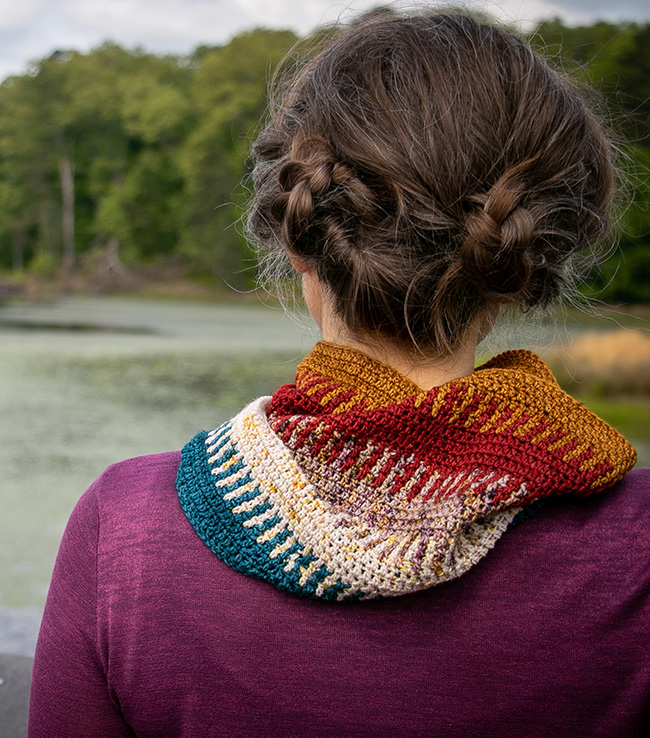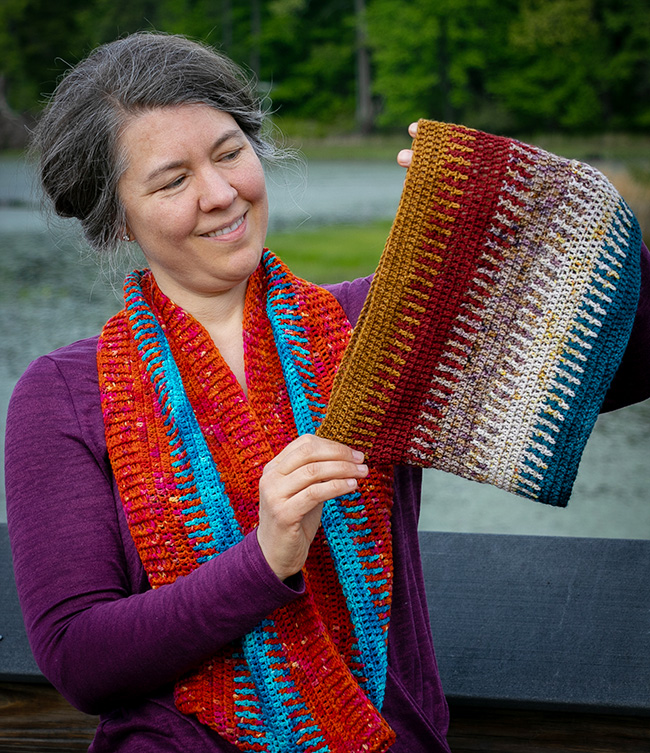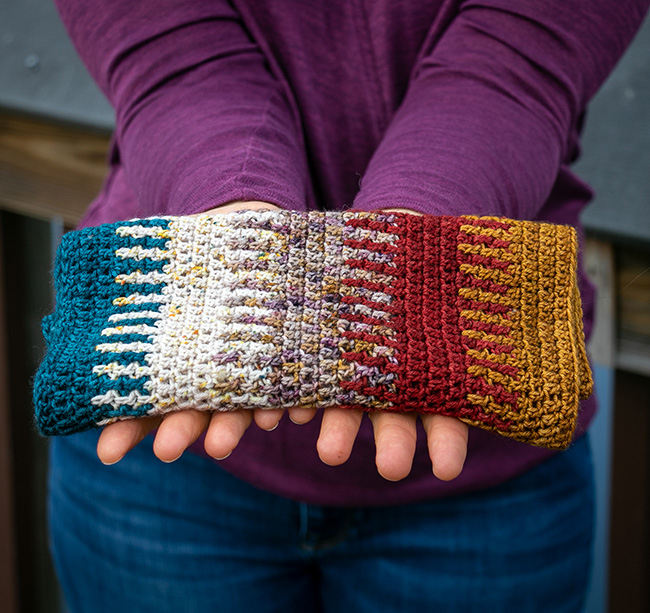Valley Vista Cowl, a free knitting pattern from Knitty.com.
INTRODUCTION
Valley Vista
 by Valerie Moreno
by Valerie Moreno
![]()
After Barbara Walker rocked the knitting world in 1976 with "Mosaic Knitting", Lily Chin developed and adapted the mosaic technique for crochet. Published in 1999 "Mosaic Magic: Afghans Made Easy", featured over 30 home décor mosaic crochet patterns. Designers and crocheters continue to evolve the technique. I learned a lot from Tatsiana Kupryianchyk, Tinna Thórudóttir Thorvaldsdóttir and Loops and Love Crochet.
Mosaic crochet is a colorwork technique. It looks hard. The secret is that you only crochet with one color at a time. It's beginner friendly, too. If you can chain, single crochet, and double crochet, you'll enjoy making this cowl. The cowl is worked in joined rounds so you're always working on the front side of the work. There's no shaping, the stitch count stays the same for the whole project! The cowl is engaging. The colorwork sections require a little focus. Your attention is rewarded with 3 vacation rounds (double crochet in each stitch).
It's tangy because you'll expand your crochet skills. The chainless foundation might be new to you, and the results are worth the extra effort. For me, I get a better Round 1 gauge and the top and bottom edges match. The mosaic crochet dips down into the row below and adds surface texture. The post ribbing keeps the Large Size edges flat.
Valley Vista comes in two sizes. If you prefer a turtleneck cowl, the Small fits close to the body and uses 5 mini skeins (or leftovers). The Large is a versatile accessory. Wear it like infinity scarf or looped twice for warmth. The Large uses 2 different full skeins.
When choosing colors, look for high contrast. Tonal and speckles are great together. Small color runs and pops. If the muse of inspiration calls to you, mix and match the pattern components for a one-of-a-kind cowl!
The pattern name is inspired by Valley Vista Boulevard in Los Angeles. The horizontal bands of color remind me of the iconic L.A. sunset with the hazy foreground, valley landscape, mountains, and faraway sky. Vista originally referred to a tree-lined avenue. The stacked mosaic stitches create repeating vertical lines.
 model: Valerie Moreno
model: Valerie Moreno
 photos: Lucy Elville
photos: Lucy Elville
SIZE
S[L]
FINISHED MEASUREMENTS
Circumference: 23.5[49] inches/ 60[124.5] cm
Length: 9.5[8] inches/ 24[20] cm
MATERIALS
Small:
Yarn (shown below)
29 Bridges Studio Go To Sock Mini Skeins [75% superwash merino wool, 25% nylon; 92yd/84m per .7oz/20g skein];
![]() [CC1] Curaco; 1 mini skein
[CC1] Curaco; 1 mini skein
![]() [CC2] Cider; 1 mini skein
[CC2] Cider; 1 mini skein
![]() [CC3] Cali; 1 mini skein
[CC3] Cali; 1 mini skein
![]() [CC4] Moraine; 1 mini skein
[CC4] Moraine; 1 mini skein
![]() [CC5] Amber; 1 mini skein
[CC5] Amber; 1 mini skein
Large: Yarn (shown at top)
Sassy Black Yarns Fingering/Sock Weight [70% superwash merino wool, 30% nylon; 437yd/400m per 3.5oz/100g];
![]() [CC1] Hot Like Fire; 1 skein
[CC1] Hot Like Fire; 1 skein
![]() [CC2] Blueberry Blue; 1 skein
[CC2] Blueberry Blue; 1 skein
Recommended needle size
[always use a needle size that gives you the gauge listed below - every knitter's gauge is unique]
![]() US F #5/3.75mm crochet hook
US F #5/3.75mm crochet hook
Notions
![]() open-ring/removable stitch markers (optional) to count the first round
open-ring/removable stitch markers (optional) to count the first round
![]() yarn needle
yarn needle

GAUGE
18 sts/16 rounds = 4 inches/10 cm in Mosaic Stripe.
PATTERN NOTES
[Knitty's list of standard abbreviations and techniques can be found here.]
Construction method: This pattern is crochet in the round, seamlessly.
Each round is joined with a slip stitch into the first stitch of the previous round, chain 1 and make the first stitch of the new round in the slip stitch space.
Colors are changed at the joined-round slip stitch. With 2 loops on hook, yo with new color, draw a loop through.
Techniques:
Fdc: Foundation double crochet. A foundation double crochet is a double crochet that is worked through the bottom 2 loops of the previous stitch. The additional yarn over functions as the foundation chain. Set Up: Begin with a loose slip knot on the hook and chain 3. Yarn over, insert the hook into the first chain (closest to the slip knot), yarn over and draw through 1 loop. 3 loops on the hook. Next, yarn over, draw through 1 loop (1 base ch made). Complete the double crochet as normal. The set-up is the first stitch and included with the final stitch count. Continue: Start with a yarn over, insert the hook into 2 loops at the base of the previous stitch, draw a loop through. Yarn over, draw through 1 loop (1 base ch made, 3 loops on hook). Complete the double crochet as normal. Work until you have made the required number of stitches.
Fpdc: Front post double crochet. A front post double crochet is a double crochet stitch that is worked around the vertical post of the stitch below. Work a standard dc, but instead of inserting the hook into the top of dc, insert the hook front to back between stitches, behind the dc, and between stitches to the front. The post of the dc travels over the crochet hook.
Bpdc: Back post double Crochet. A back post double crochet is a double crochet stitch that is worked around the vertical post of the stitch below. Work a standard dc, but instead of inserting the hook into the top of dc, move the hook to the back of the work, insert the hook back to front between stitches, over the dc, and between stitches to the back of the work. The crochet hook travels over the post of the dc.
Mdc: Mosaic Double Crochet. A mosaic double crochet is worked like a standard double crochet, but into the dc 2 rounds below (over the ch2 of the previous round).
Mosaic Stripe Pattern
Note: Each time you work this pattern, you will only use two colors, BUT which two colors you are using will change.The color changes are noted in the Begin Mosaic Stripe Pattern section in the pattern.
Leave yarns attached unless otherwise noted, loosely carrying them up on the inside when not in use. When starting Rounds 3, 4, 5, and 6, you will need to loosely bring the color up on the inside of the work, to begin working with it. Simultaneously join the round and change colors with the last slst of the round.
Round 1: With color 1, ch1, dc into the same sp as the slst, sk 1 st, ch 2, *dc, sk 1 st, ch 2; rep from * to end. Drop color 1, join the round and color 2 with a slst into first dc. 54[108] dc, 54[108] ch 2 sp.
Round 2: With color 2, ch1, *Ch 2, sk 1 st, mdc; rep from * to end, join the round with color 1 with a slst into first ch2 sp. 54[108] dc, 54[108] ch 2 sp.
Round 3: With color 1, ch1, *mdc over ch2 spc, sk 1 st, ch2; rep from * to end, join the round with color 2 with a slst into the first mdc. 54[108] dc, 54[108] ch 2 sp.
Round 4: With color 2, repeat Round 2.
Round 5: With color 1, repeat Round 3. Leaving a tail of approximately 6 inches/15 cm, cut color 1.
Round 6: With color 2, ch 1, *dc, mdc; rep from * to end, slst into first dc. 54[108] dc, 54[108] mdc.
Rounds 7, 8, 9: Cont with color 2, ch1, dc into the same sp as the slst, dc into each st around, slst into the first dc. 108[216] dc.
DIRECTIONS

Both Sizes, Setup:
Round 1: With crochet hook and CC1, ch3 (counts as first fdc), fdc 107[215] times. To make counting easier, mark every 12 stitches with a crochet marker. Join with slst to the top of beginning fdc, being careful not to twist. 108[216] fdc.
Size Small only:
Rounds 2-3: Ch1 (after you've made the chain, pull the working yarn so the chain is snug), dc into the same sp as the slst (working the first dc with slightly looser tension to avoid a pucker) dc into each st around, join with a slst to the top of first dc (just like the first ch1, pull the working yarn to get a snug slst). 108 dc.
Begin Mosaic Stripe Pattern:
Work Rounds 1-9 with CC1 as Color 1, and CC2 as Color 2.
Work Rounds 1-9 with CC2 as Color 1, and CC3 as Color 2.
Work Rounds 1-9 with CC3 as Color 1, and CC4 as Color 2.
Work Rounds 1-9 with CC4 as Color 1, and CC5 as Color 2.
After completing the last Round 9, work a slst into first dc of previous round. Leaving a tail of approximately 6 inches/15 cm, cut yarn and fasten off.

Size Large only:
Ribbing:
Rounds 2-6: Ch1, *Fpdc into the first stitch, bpdc into the second stitch; rep from * to end, slst into top of beg fpdc. 108 fpcd, 108 bpdc, 216 sts.
Rounds 7-9: Ch1, dc into the same sp as the slst, dc into each st around, join with slst, into the first dc.
Begin Mosaic Stripe Pattern:
Work Rounds 1-9 with CC1 as Color 1, and CC2 as Color 2.
Work Rounds 1-9 with CC2 as Color 1, and CC1 as Color 2.
Cont with CC1, work Ribbing as before for a total of 6 ribbing rounds.
After completing the last rib round, slst the last stitch with the first stitch. Leave a tail of approximately 6 inches/15 cm, cut yarn and fasten off.

FINISHING
Weave in ends. Close the gap at the lower edge by using the yarn tail to seam the first and last foundation stitches together. Continue weaving the ends so they are invisible from the front side. For best result, wet block by soaking the work in cool water with a small amount of wool wash for about 20 minutes. Support the work and drain the water. Squeeze and press excess water out (a clean salad spinner works great for this!). Lay flat to dry.
ABOUT THE DESIGNER
 It's unsatisfying that Valerie doesn't remember when she learned how to knit and crochet. She picked up her hooks, needles, and yarn as an adult during a time of grief and loss. Knitting Fairy Godmother is a reminder to lighten up and have some fun.
It's unsatisfying that Valerie doesn't remember when she learned how to knit and crochet. She picked up her hooks, needles, and yarn as an adult during a time of grief and loss. Knitting Fairy Godmother is a reminder to lighten up and have some fun.
Right now, Maryland is home which is lucky because it's a year-round hotspot for the fiber arts. She plans an annual fiber festival, Yarncentrick and teaches crochet and knitting around the country. Professionally, she's an Inventory Planner in the retail industry.
Follow on Social Knitting FairyGodmother.
Pattern & images © 2023 Valerie Moreno